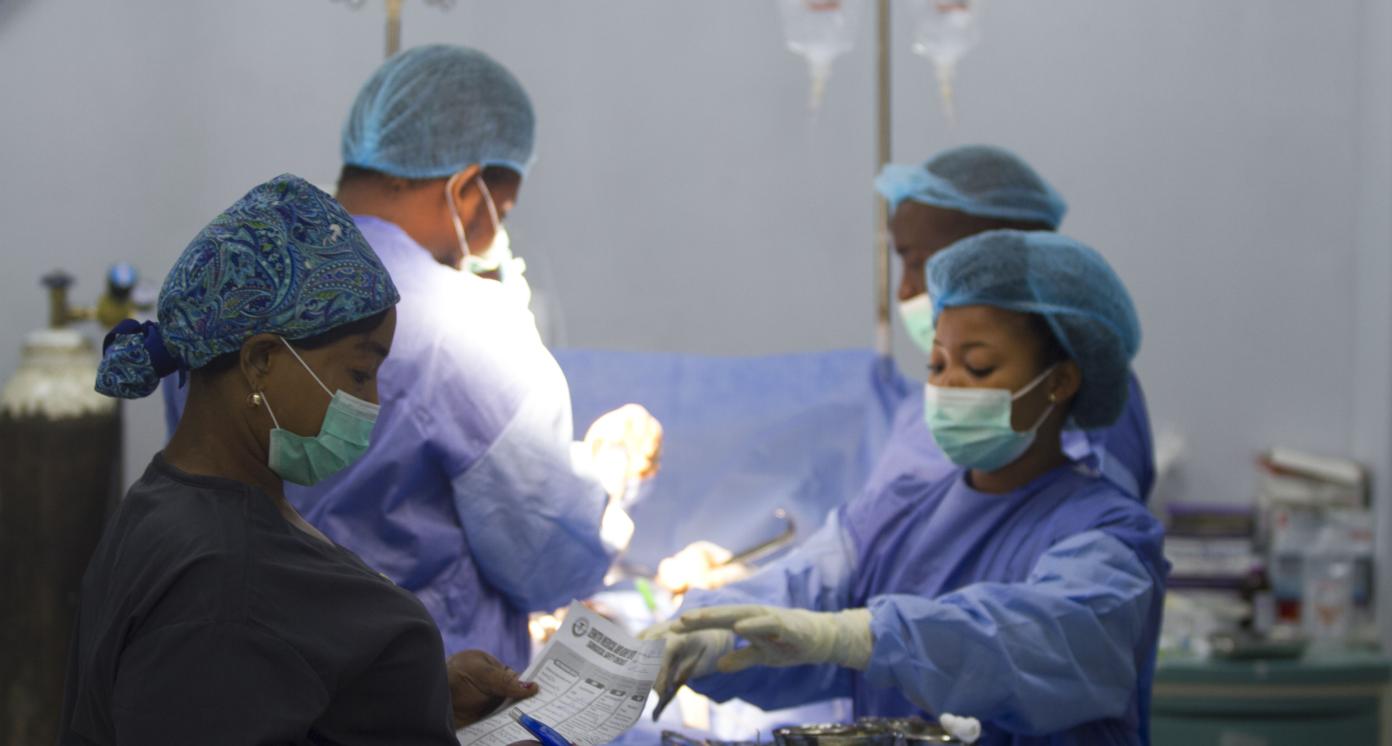Healthcare consumables



Business Model Description
Manufacture healthcare consumables.
Expected Impact
Improve coverage of healthcare service delivery, and increase access to quality healthcare.
How is this information gathered?
Investment opportunities with potential to contribute to sustainable development are based on country-level SDG Investor Maps.
Disclaimer
UNDP, the Private Finance for the SDGs, and their affiliates (collectively “UNDP”) do not seek or solicit investment for programmes, projects, or opportunities described on this site (collectively “Programmes”) or any other Programmes, and nothing on this page should constitute a solicitation for investment. The actors listed on this site are not partners of UNDP, and their inclusion should not be construed as an endorsement or recommendation by UNDP for any relationship or investment.
The descriptions on this page are provided for informational purposes only. Only companies and enterprises that appear under the case study tab have been validated and vetted through UNDP programmes such as the Growth Stage Impact Ventures (GSIV), Business Call to Action (BCtA), or through other UN agencies. Even then, under no circumstances should their appearance on this website be construed as an endorsement for any relationship or investment. UNDP assumes no liability for investment losses directly or indirectly resulting from recommendations made, implied, or inferred by its research. Likewise, UNDP assumes no claim to investment gains directly or indirectly resulting from trading profits, investment management, or advisory fees obtained by following investment recommendations made, implied, or inferred by its research.
Investment involves risk, and all investments should be made with the supervision of a professional investment manager or advisor. The materials on the website are not an offer to sell or a solicitation of an offer to buy any investment, security, or commodity, nor shall any security be offered or sold to any person, in any jurisdiction in which such offer would be unlawful under the securities laws of such jurisdiction.
Case Studies
Country & Regions
- Nigeria: South West
- Nigeria: North Central (Middle Belt)
Sector Classification
Health Care
Development need
The Sustainable Development Report 2019 scores Nigeria 28.0 on SDG 3. Indicators of maternal mortality, incidences of tuberculosis, life expectancy and adolescent fertility have stagnated. All other indicators show very little or no improvement.(1)
Policy priority
The Federal government health policy focuses on improving availability, accessibility, affordability and quality of health services by: increasing access to and revitalizing primary health care; expanding coverage to all local governments; providing sustainable financing via health insurance schemes; and reducing infant and maternal mortality rates.(2)
Gender inequalities and marginalization issues
33.5% of women and girls 15 years and older still experience violence and emotional abuse, according to National Bureau of Statistics data from 2015. In 2015, 24.8% of women aged 15-49 made their own informed decisions regarding sexual relations, contraceptive use and reproductive health care. Early marriage impedes the growth and development of the girl-child, and exposes her to Vescio Virginal Vistulae (VVF), the Human Immune Virus (HIV) and Acquired Immuno-Deficiency Syndrome (AIDS). The percentage of girls and women who have undergone female genital mutilation/cutting remains as high as 39.9%.(13)
Investment opportunities introduction
An estimated USD 1 billion is spent annually on outbound medical tourism.(3)
Key bottlenecks introduction
Several challenges still persist including poor infrastructure, inequitable access, limited human resources and inadequate financing.(2)
Health Care Providers
Development need
Population growth increases the number of patients in need of diversified health services, particularly when 72% of health expenditure is out-of-pocket payments.(4)
Health Care Delivery
Pipeline Opportunity
Healthcare consumables
Manufacture healthcare consumables.
Business Case
Market Size and Environment
> USD 1 billion
The market size for medical consumables is estimated at USD 59 million in 2020 and is projected to reach up to USD 65.2 million in 2021. Consumables represent the largest product area in the Nigerian medical device market, accounting for more than 30% of imports in 2016.(6)
Indicative Return
10% - 15%
The estimated return rate for investors is 10.8% - 12.8%. This rate is a benchmark calculated as a cost of equity, reflecting an average return required by investors active in the subsector.(7)
Investment Timeframe
Medium Term (5–10 years)
Investments in healthcare consumables manufacturing are expected to generate cashflow within 5 years and profit within 7 - 8 years. (6)
Ticket Size
USD 1 million - USD 10 million
Market Risks & Scale Obstacles
Capital - Limited Investor Interest
Market - Highly Regulated
Business - Supply Chain Constraints
Impact Case
Sustainable Development Need
The health sector is underperforming or stagnating in all SDG indicators according to the Sustainable Development Report 2019. Nigeria's Universal Health Coverage Tracer Index is at 46.4.(1) Life expectancy is at 55.2 years, and the mortality rate for under-5s is 110.2 per 1,000 live births. Undernourishment continues to have a negative trend with 11.5% of Nigeria’s population affected.(8)
Underfunding of essential health products means Nigeria experiences persistent stock-outs and high expirations at service delivery points, irrational drug use, poor and parallel supply chain management systems, and inadequate warehousing with available ones not meeting minimum standards.
Local manufacture is plagued by poor infrastructure and protection from unfair international competition. Local manufacture supplies only 5% of local demand for medicines and other health products. Nigeria largely depends on imports to meet local demand for health products.
Gender & Marginalisation
Nigeria's maternal mortality rate is very high (512 per 100 000 in 2018). The meagre percentage of women of reproductive age whose need for family planning is satisfied with modern methods perpetuates the poverty trap for many Nigerian women, who incur additional financial responsibilities brought on by children.(13)
Expected Development Outcome
Investments help improve access to medical equipment for better service provision.
Investments help reduce cost of importing healthcare consumables.
Investments can help increase employment in the healthcare sector.
Gender & Marginalisation
Investments can increase access to quality healthcare services for all segments of society, but particularly women and rural communities.
Primary SDGs addressed

3.1.1 Maternal mortality ratio
3.8.1 Coverage of essential health services
917 per 100,000 births (15)
42 (worst 0–100 best) (15)
Nigeria has an ambition to meet the 2030 maternal mortality ratio of under 70 per 100,000 live births.(14)
100% (15)
Secondary SDGs addressed


Directly impacted stakeholders
People
Corporates
Indirectly impacted stakeholders
People
Outcome Risks
Incorrect disposal of medical waste could be detrimental to health and the environment.
Impact Risks
Execution risk: Without careful planning, activities may not be delivered as planned and may not result in the desired outcomes.
External risk: External factors may disrupt delivery of expected impact by distorting the supply chains in medical consumables manufacturing and distribution.
Impact Classification
What
Likely to have positive outcomes such as increasing access to safer healthcare consumables and reducing the cost of healthcare products.
Who
Hospitals, pharmaceuticals, consumers
Risk
Counterfeit products
Impact Thesis
Improve coverage of healthcare service delivery, and increase access to quality healthcare.
Enabling Environment
Policy Environment
National Health Policy: In February 2017, the government approved the third iteration of the NHP, following its inauguration in 1988 and a revision in 2004.(8)
The National Health Insurance Scheme, the National Health Bill, as well as the World Bank’s USD 500 million credit and public-private partnerships (PPPs) such as the Lagos Medical Park are expected to improve healthcare services and act as a catalyst for health sector improvements.(6)
The National Health Policy dives deeper into SDGs and establishes frameworks for improving healthcare efficiency and service delivery through the following policy thrusts: governance, financing, medicines and vaccines, infrastructure, data systems, research and development, public-private partnerships (PPPs) and community participation.
Financial Environment
Fiscal incentives: The Federal government issues a 3-5 year company income tax holiday for investments in healthcare and pharmaceuticals under the Pioneer Status Incentive (PSI) Scheme. This tax holiday also applies to companies investing in manufacturing medical supplies.(9)
Regulatory Environment
National Health Act (NHA) of 2014: This Act established a legal framework for developing, regulating and managing a national health system and set standards for service provision.(8)
The health sector regulatory environment provides a favorable atmosphere for investments.
Marketplace Participants
Private Sector
Flint Atlantic Capital, Private Sector Health Alliance of Nigeria, Medipark International Limited Consortium and Ibile Holdings, SIemens Healthineers, Altona Diagnostics, Biomaxima, Genomica, Abott, BD, Biomerieux, Qiagen
Government
Federal and State Ministries of Health
Target Locations
Nigeria: South West
Nigeria: North Central (Middle Belt)
References
- (1) Sachs, J., Schmidt-Traub, G., Kroll, C., Lafortune, G., Fuller, G. (2019). Sustainable Development Report 2019. New York: Bertelsmann Stiftung and Sustainable Development Solutions Network (SDSN).
- (2) Federal Republic of Nigeria (2017). Economic Recovery and Growth Plan 2017 - 2020. Abuja: Ministry of Budget and National Planning.
- (3) Medic West Africa (2019). 2019 Healthcare market insights: Nigeria. https://www.medicwestafrica.com/content/dam/Informa/medic-west-africa/english/2019/HealthcareInsights.pdf
- (4) World Bank Database.
- (5) Flint Atlantic (2018). Who we are. http://www.flint-atlantic.com/about-us/
- (6) Medic West Africa (2019). 2019 Nigeria medical device overview. https://www.medicwestafrica.com/content/dam/Informa/medic-west-africa/english/2019/NigeriaMedicalDeviceMarketOverview.pdf
- (7) PwC analysis (2020), based on Prof. A. Damodaran data.
- (8) Sachs, J., Schmidt-Traub, G., Kroll, C., Lafortune, G., Fuller, G. (2019). Sustainable Development Report 2019. New York: Bertelsmann Stiftung and Sustainable Development Solutions Network (SDSN).
- (9) Nigerian Investment Promotion Commission (2020). Tax holiday available to the medical and pharmaceutical sectors. https://nipc.gov.ng/2020/04/14/tax-holiday-available-to-the-medical-and-pharmaceutical-sectors/
- (10) State Intel. https://estateintel.com/development-lagos-state-medical-park-medipark-ikoyi-lagos/
- (11) Abuja-Ng.com (2014). Abuja medical city project. https://www.abuja-ng.com/abuja-medical-city-project.html
- (12) Agary Pharmaceutical (2021). Agary Pharmaceutical Ltd .... trusted quality. https://www.agarypharm.com/about-us-2/
- (13) Federal Republic of Nigeria (2017). Implementation of the SDGs: a national voluntary review. https://sustainabledevelopment.un.org/content/documents/16029Nigeria.pdf
- (14) Federal Republic of Nigeria (2020). Integration of the SDGs into National Development Planning: A Second Voluntary National Review (2020). https://sustainabledevelopment.un.org/content/documents/26309VNR_2020_Nigeria_Report.pdf
- (15) Sachs, J., Schmidt-Traub, G., Kroll, C., Lafortune, G., Fuller, G., Woelm, F (2020). The Sustainable Development Goals and COVID-19. Sustainable Development Report 2020. Cambridge: Cambridge University Press. https://dashboards.sdgindex.org/profiles/NGA
















